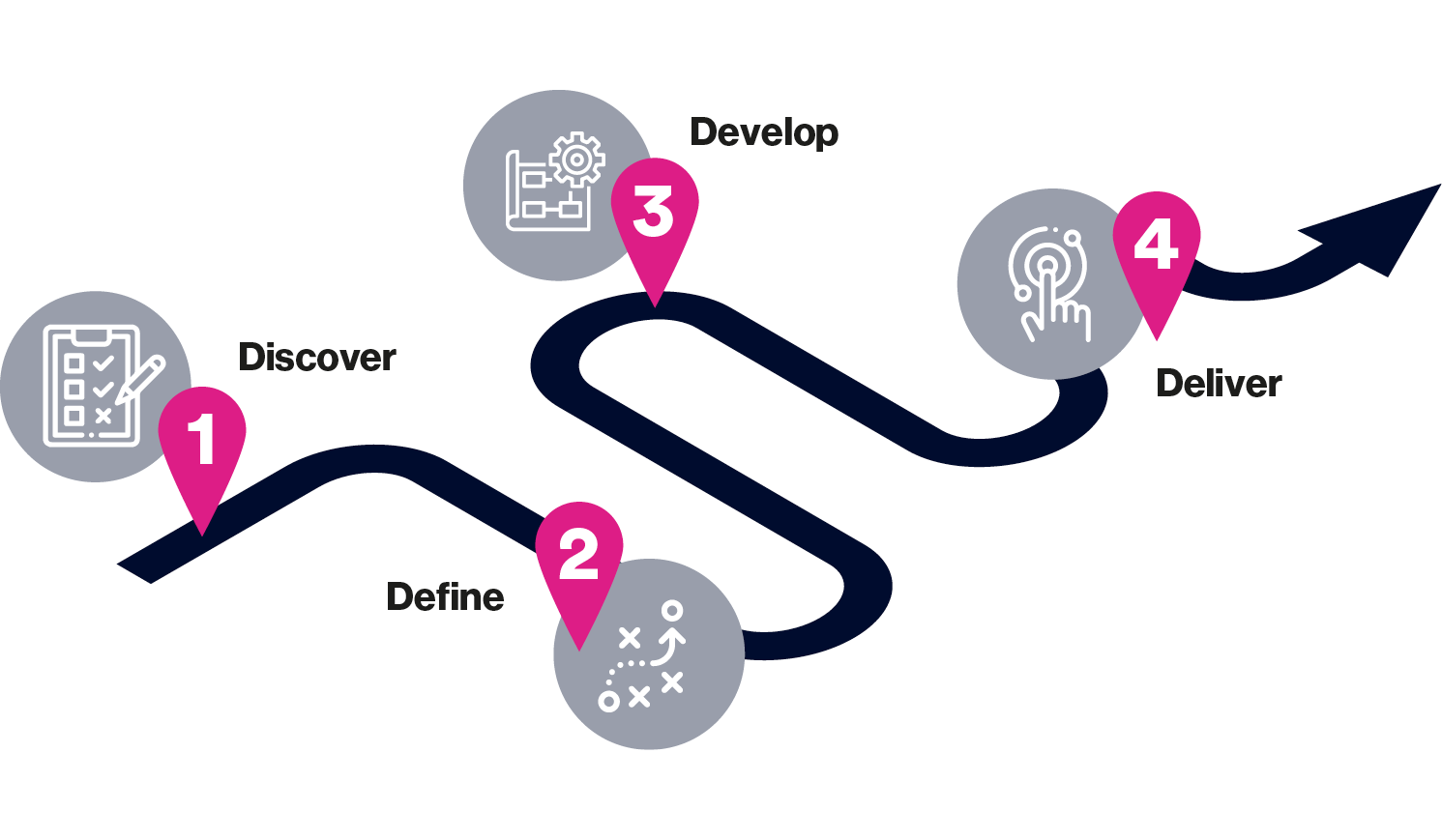
Develop your digital road map to guide your business in the digital age
As the classic saying goes ‘fail to plan then plan to fail’, well the same applies when adopting technology, it needs to be carefully planned and managed to make sure that you gain the maximum business benefits.
The reality is that most technology adoption projects fail because:
- of a lack of a planning,
- people have not been effectively engaged,
- an absence of clear goals,
- of a focus on the technology rather than the delivery of business benefits.
These factors can combine to create confusion and a lack of clarity.
This simple step by step guide is designed to help you to avoid these common pitfalls. Through following our simple and yet powerful process we will help you to develop a Digital Roadmap for your business and realise the vision and goals to which you aspire!
What is a digital roadmap?
A digital road map helps businesses to pinpoint how digital technology can improve performance and accelerate the achievement of an organisations vision and goals. Like a satnav, its job is to help you to arrive at your chosen destination on time and via the quickest and most effective route.
The Winning Moves Digital Roadmap framework
The Digital Roadmap is structured around the Winning Moves Digital Transformation Framework, developed with funding from the Department for Business Energy and Industrial Strategy in partnership with Aston University Business School. The tool is built on rigorous research into how the best performing businesses adopt technology meaning that following this guide will help you to adopt the practices of high performing businesses and maximising your chances of success.
The framework is structured around 5 Value Dimensions that provide a holistic view of digital adoption and performance.
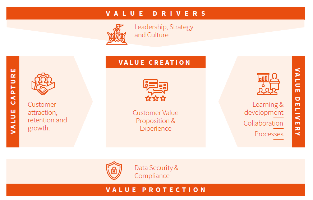
Value Drivers
Digital transformation needs to be driven form the top, leaders must believe passionately in the role digital technology has in driving business performance. They develop customer centric cultures who collaborate, change and create to deliver value to customers. Everyone is tuned into the businesses vision, values and goals and understand the part they and digital adoption plays.
Value Creators
Value creators define how the business uses digital technology to grow its value proposition and to differentiate from the competition. Value creation considers how digital technology is used in product, service and customer experience design and delivery. This could include the use of augmented reality to bring products to life, connected devices, the presentation of analytics or the integration of apps that allow users to control their interaction with products and services from their smart phone.
Value Capture
Value capture is about how businesses access new customers and markets as well as growing the value of their existing customers. Value capture considers areas such as marketing automation, use of data and analytics to gain customer insights and how technology can present new channels to market and opportunities to grow the value of existing relationships.
Value Delivery
Value delivery is focused on how businesses use digital technology to drive processes and operational infrastructure. Value delivery considers how efficiently product and services are fulfilled and delivered to customers. Value Delivery will typically include the automation of operations, adoption of Enterprise Resource Planning systems, inventory, stock and supply chain management systems as well as the development of the digital skills and the partnerships required to adopt technologies.
Value Protection
Value protection is concerned with business resilience, continuity, and reputation. It considers areas such as cyber security, financial management and compliance with legislation such as GDPR, within the business and across its supply chain.
The Digital Roadmap Process
The Winning Moves Digital Roadmap process is structured against a simple 4 stage process, ensuring that users (people) and the achievement of the business’s vision and goals remain the central focus.
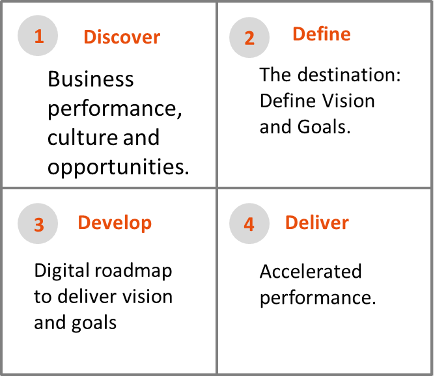
The output is a 1 page Digital Roadmap Canvas that clearly pinpoints how technology will:
- Enhance your business model and the customer/employee experience
- Accelerate the achievement of business goals
- Deliver on opportunities available to your business
- Help to address and mitigate threats and risks faced by your business
The below example illustrates what a digital roadmap canvas for a hairdresser with ambitions plans for growth could look like.
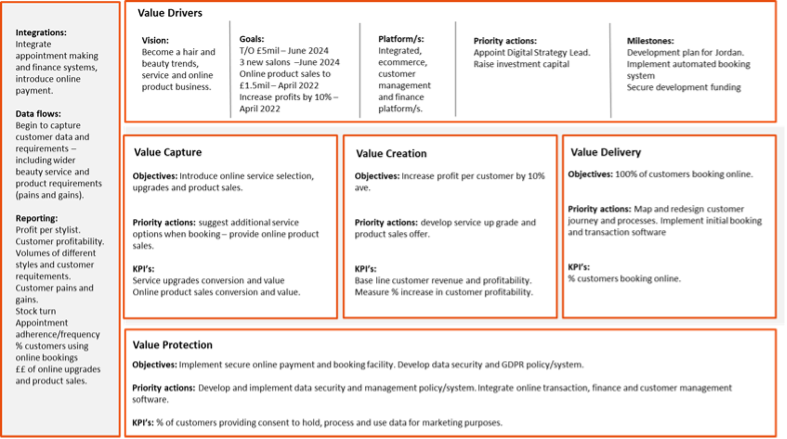
Stage 1: Discover – your current performance, culture and opportunities
This is all about laying the strong foundations on which your Digital Roadmap can be built. In the discovery stage we will focus on:
- Building your Digital Roadmap Team.
- Reviewing your use of digital technology.
- Completing a TOWS analysis canvas.
Build your Digital Roadmap team
Getting the right people involved in the development and delivery of your roadmap is essential, it’s these people who will engage others from across your business and help to get them aligned to and behind the plan.
When building your team make sure of the following:
- You have representation from senior leadership, someone who will act as the project sponsor and visibly champion digital technology and its adoption.
- That people from across the business, from every level and across every function are included – this could also demand the involvement of critical suppliers.
Tool: Review your current strengths and weaknesses
Before jumping in feet first it’s useful to establish your starting point, how well do you currently adopt technology, how effective is it used to drive business performance and what are the strengths that you can build on and the weaknesses and bottlenecks that need to be addressed.
To review your performance, ask each of your digital roadmap team to complete the Elevate online digital technology assessment.
Tool: Agree on your strengths, weaknesses, opportunities, and threats
Once every member of the roadmap team has completed the online assessment summon them together into an on or offline workshop.
Using the results of your Digital Technology Assessment and the TOWS (Threats, Opportunities, Weaknesses and Strengths) analysis canvas (provide link to template) provided and illustrated below, ask people to:
- Identify and document the threats and opportunities for each value dimension.
- Then for each threat document ideas on how the business can build on its strengths and address its weaknesses to mitigate the threat.
- Finally focus on opportunities, how can you build on your strengths and address your weaknesses to capitalise on an opportunity.
Congratulations – through this process you have started to build your digital roadmap!
The below example illustrates what a TOWS analysis canvas for a hairdresser with ambitions plans for growth could look like.
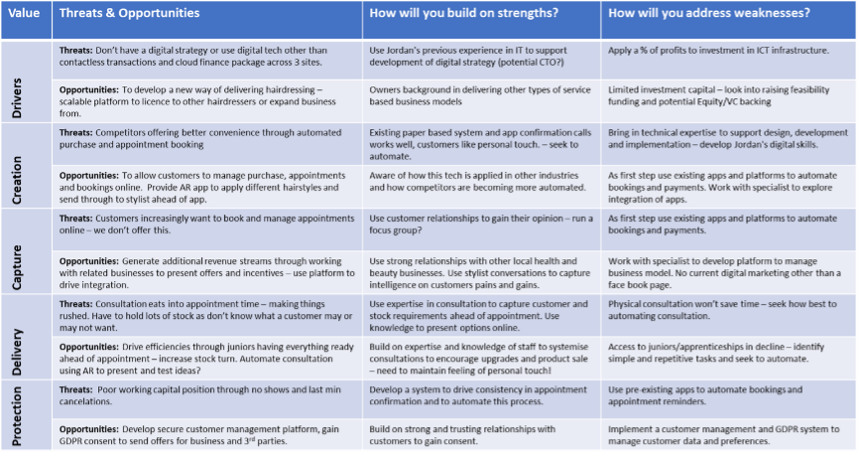
Stage 2: Define – your vision and goals.
Vision is a key tool for leaders when aligning people’s collective energy and resource towards a common goal, the clearer and more compelling you vision is the better, people need to be able to connect with it, feel excited about it and understand the part that they will play in achieving it! This isn’t about technology, but rather about defining the vision and goals that technology will help you to achieve.
When setting goals most businesses look at what they did last year and add 10% – that’s great but it essentially means that to achieve that 10% you will do ‘a little more’ of the same and as a result you are unlikely to get the best out of technology.
Setting stretching goals however creates a backdrop for the introduction of the technology that will help you to deliver high performance. Stretching goals will make you question the way you do things and look for new possibilities, ultimately it will catalyse innovation!
During the discovery stage we will focus on the following two tools:
- Defining your destination – creating your vision for the future.
- Setting stretching goals- wouldn’t it be great if….
Tool: defining your destination – vision for the future.
Imagine for a moment that the date is three years from today and that you are hosting a party. It is a party to celebrate your company’s success at achieving your three-year vision – a vision which at its inception was ambitious and stretching, yet achievable. Try to project your mind to the party.
- Where is it?
- What is the atmosphere?
- Who is there?
- What exactly are you celebrating?
Write it down in as much detail as possible, capture everything that’s going on – the sights, sounds and smells.
- What are people saying about you and your company?
- What are they saying about your use of digital technology?
Think of it as a movie script and describe the event in real time.
- Is someone making a speech?
- Is there a presentation?
- If so, what for?
When doing this exercise, try to be as specific as possible in every detail.
- What has your success meant for you, to your staff and to your customers?
- What role has digital technology had in your success?
- Why do people want to work for your company?
- Why do customers want to use your services or products?
All these things and any more you might think of should be included in your description of the event.
Once you have completed the exercise as yourself three questions:
- Does the success described in your celebration excite you?
- Do you think it is something that would excite and unite your staff?
- Do you think it is achievable?
If the answer is yes then you have just created a compelling vision for the future of your business – congratulations!
Tool: setting stretching goals- wouldn’t it be great if….
Wishful thinking is an extremely powerful way of generating ideas and innovations. The basic premise of the technique is simple:
- First start with a statement or question which expresses a deeply felt aspiration or desire.
- It’s critical that the subject of the question is something worth getting excited about,
- Something that you truly would wish for,
- And often the more unreasonable (stretching), the better.
Having identified the wish, the next step is simply to ask the questions:
- What would this mean if this wish were to come true?
- What would have happened?
Now capture these ‘what ifs’:
- Your turnover had doubled?
- All your products were market leaders?
- You could double your selling price?
- Your production time was cut in half?
- Absenteeism was 0%
- Etc…….
Choose the ones that you think that if achieved will move you closer towards your vision and that are stretching yet achievable. You now have a set of stretching goals that will help you to do two things:
- break you out of the constraints of conventional thinking
- begin the quest for new ideas
Bringing it together
Now that you’ve defined your destination (vision) and figured out the goals that will get you there, you now need to document these on your digital road map canvas – everything thereafter will be designed to achieve your vision and goals!
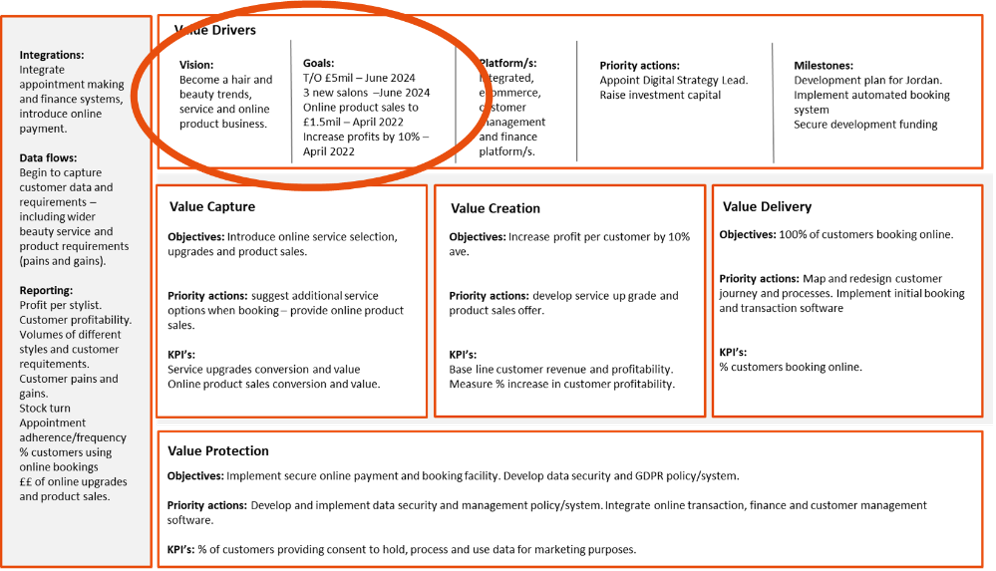
Stage 3: Develop – a digital road map designed to hit your vision and goals!
You should now be feeling really excited about the future and the role digital technology is going to play. During the first two stages (discovery and define) you have:
- reviewed your business model,
- baselined how you currently use technology,
- identified your threats, opportunities strengths and weaknesses,
- created a compelling vision for the future,
- defined a set of stretching goals,
- and generated a load of ideas in the process.
It’s now time to prioritise, to relook at the ideas that you’ve developed and to identify the ones that will have the biggest impact on the achievement of your vision and goals.
During stage 3 Develop we will introduce two tools designed to:
- Prioritise and choose the best ideas
- Build your Digital Road Map Canvas.
Tool: Prioritising and choosing the best ideas
You will now have generated loads of ideas, no doubt too many and you won’t be able to take them all forward, it’s therefore essential to prioritise the ideas that you would like to move forward to the next level.
To help to identify which ideas have the most potential and to prioritise the order of which ideas should be moved forward ask the team to score each idea on a scale of 1 to 5 (1 = Negative position, 5 = positive position) against the following criteria:
- Alignment with the business’s Vision for the future
- The impact the idea will have on the achievement of strategic Goals
- The Time commitment required to move the idea forward
- How much it will Cost to implement the idea.
- How accessible the Skills are to move forward the idea?
Once scores have been applied to each idea in each value dimension add them up – the ideas with the highest score should have the greatest potential.
This isn’t an exact science and ideas also need to excite and energise people. What this exercise does do is allow the Road Map Team to discuss each idea in greater depth and from different angles helping to arrive at a better informed decision.
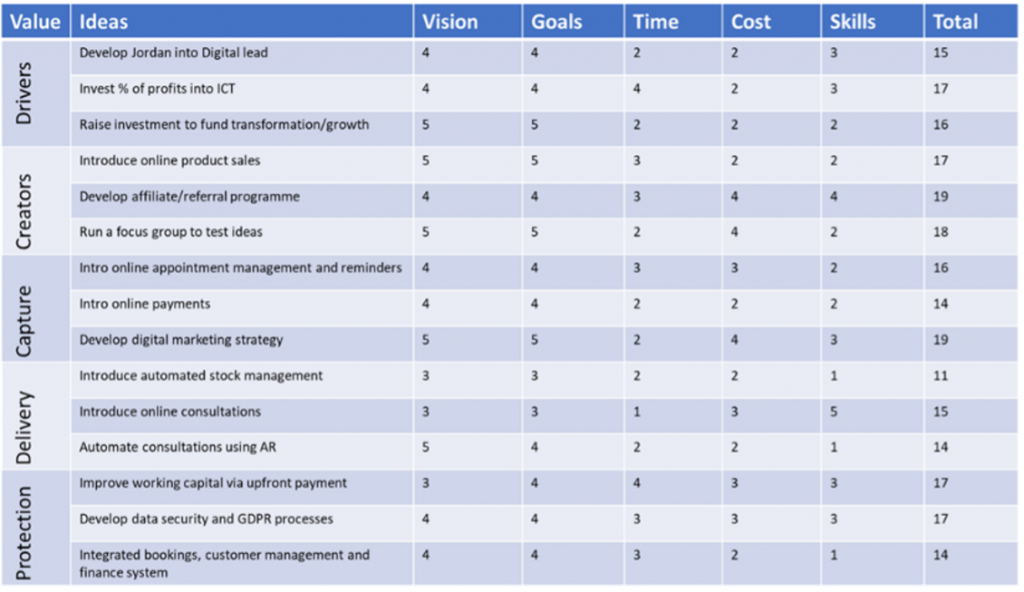
Tool: Building your Digital Road Map Canvas.
Now that you’ve selected the ideas that you want to focus on and that will support the achievement of your vision and goals it’s now time to convene your Road Mapping Team together to build your canvas:
In a workshop environment draw your Road Map Team together to build your Road Map Canvas and based on the implementation of your chosen ideas:
- Define your objectives for each value dimension (e.g. value capture – to introduce a new e-commerce system)
- Then define your Key Performance Indicators (KPIs) for each dimension (e.g. value capture – generate £8k sales per month through e-commerce). Ensure that your KPI’s align directly to the achievement of vision and goals.
- In the left-hand column of the canvas:
- capture the how different technologies need to integrate and
- how data need to flow between applications and be reported on.
The Canvas is designed to focus on the achievement of the business’s vision for the future but is also focused on the completion of short-term actions. Use the canvas as a live document reviewing it alongside the Road Map Team at least every 30 days, updating progress against KPI’s and reviewing and resetting objectives and actions. This process will help to ensure that progress is being made towards the achievement of vision and goals.

Stage 4: Deliver – your Digital Roadmap
You’ve now developed your 1-page Digital Roadmap, and you’ve assembled a stellar Roadmap Team who are all excited and ready to lead the implementation of your Digital Roadmap. The hard work starts now! Our top tips to support successful implementation include:
Don’t forget the people: remember that technology is an enabler, it’s a collection of software and hardware that will help you to achieve your goals. People need to recognise that technology is there to make their lives easier and to boost performance and levels of success, it’s important therefore to keep a razon like focus on the users of technology and to help them to recognise the benefits that it already is or will deliver in the future.
Delivery quick wins: a great way of reinforcing that technology is friend and not a foe is to deliver quick wins. These may not be the ideas that will deliver the biggest performance impacts but they are likely to be projects that will reinforce to people that the effective use of technology is a good thing and is there to make life easier. Quick wins could be relatively simple implementations such as automating expense claims or timesheets – admin tasks that people consider to be pain!
Develop the Roadmap Team: keep the team together, the road map team are your change agents, they will connect with and support others from across the business helping to make sure that everyone is onboard and pulling in the same direction, they also help to suppress the effect of the more cynical employees.
Rhythm and discipline: keep using the canvas as a live document, everything on the canvas, other than Vision and Goals, will change on a regular basis, so keep reviewing it with the Roadmap Team at least every 30 days.
Develop skills and capability: levels of digital skills will vary across your business, often the reason behind people’s scepticism is their lack of exposure to technology and digital skill. It’s important to understand and map levels of digital skills across your business and to identify development requirements. The great news is that there are loads of free online courses available as well as funded support which can be found in the funding and support section.
Utilise the funding and support available to your business: its likely that you will need to bring in external expertise to support the implementation of certain sections of your canvas.
- The funding and support section of the Elevate digital technology portal has oodles of options that are available for your business.
- The Technology area and Sector sections of the Elevate portal are full of useful guides, factsheets, and innovations that you can use to develop your knowledge.
- If you’re still unsure the Worcester Growth Hub – Business Central team are on hand to signpost you to the most appropriate funding and support.
- This useful guide on selecting technology providers from Be the Business may also help you to choose the right suppliers for your business requirements.
We hope that you’ve found this guide useful – happy road mapping!


